|
|
|
|
Kitchen Deities in Japan
|

SHINTO: Kamado-no-Kami
God of the Cooking Stove
|

BUDDHIST: Kōjin
|
|
This page is dedicated to Kōjin (Kojin, Koujin, Koojin), the syncretic Shinto-Buddhist deity of the kitchen and the cooking stove (kamado, 竃, also written 竈, also abbreviated as “kama”). Before starting, please note there are other deities in Japan associated with the hearth.
- Daikokuten 大黒天 (Skt. Mahakala). The god of wealth, farmers, the kitchen, and provider of food. Daikokuten’s three-headed version shares some of the same attributes as Sanbō Kōjin (below) -- both deities are worshipped as kitchen gods and in the common mind considered identical.
- Idaten 韋駄天 or 違駄天 (Skt. Skanda). Kitchen deity, especially at Zen monasteries. Idaten is also known as the protector of monks and monasteries.
- Monju Bosatsu 文殊菩薩 (Skt. Manjushri). Deity of wisdom and intelligence, whose effigy was placed in residential kitchens during the Heian era to symbolize the wisdom and discipline needed to maintain the home.
- Suijin 水神. Japanese Water Kami. Shinto goddess who protects not only fishermen, but serves as the patron saint of fertility, motherhood, and easy childbirth. She is the patron deity of the famous Tsukiji Fish Market 築地市場 in Tokyo, where she is enshrined, and is also reportedly enshrined in many domestic kitchens as an essential household god.
- Mikuriya Myōjin 御厨明神 and Ajimi Jizo 嘗試地蔵. Kitchen Deities in the Shingon Tradition at Mt. Kōya 高野. See details below.

Kōjin (Kojin) and Sanbō Kōjin (Sanbo Kojin)
God of the Hearth & Kitchen Fire
Protector of Land, Cattle and Horses
Defender of the Three Buddhist Treasures
Sanbō Kōjin (Sanbo, Sanpo, Sambo, Sampo)
Kōjinsama (Kōjinsan, Kojin, Kojinsama, Kojinsan, Koojin)
Nyorai Kōjin, Kojima Kōjin, Kamado-no-Kami, Kama-no-Kami

|
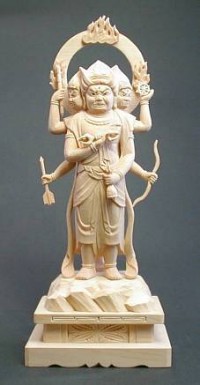
Sanbō Kōjin 三宝荒神
Modern Reproduction
Photo www.butuzou.co.jp
|
Sanbō Kōjin (less commonly known as Sanpō Kōjin) because the deity protects the Three Jewels (Sanbō 三宝), which are the Buddha, the Dharma (Buddhist law), and the Sangha (community of Buddhist believers). Another Japanese deity of the kitchen, Sanmen Daikokuten, shares similar iconography.
|
|

WAN
Seed Syllable
for Sanbō Kōjin
Mantra (Japanese)
おん けんばやけんばや そわか
Seed & Mantra
courtesy this site
|
|
 Kōjin-sama 荒神 ・ 荒神様 ・ 荒神さん Kōjin-sama 荒神 ・ 荒神様 ・ 荒神さん
The syncretic god of the hearth, the kitchen fire, and the protector of land, cattle and horses. His name includes the Shinto term for “kami,” although his iconography suggests a Buddhist origin, for his wrathful appearance is typical of the Myō-ō. Nevertheless, his devotees are found in both Shintō and Buddhist camps. Images of this deity do not appear widely until the Muromachi Era (15th century). This deity is also closely associated with a three-headed form of Daikokuten (god of wealth, agriculture, the kitchen, farmers, and one of Japan’s Seven Lucky Gods) known as Sanmen Daikoku. .
Below Text Courtesy of JAANUS. Text edited slightly by Schumacher. Kōjin is a god who protects against disaster and brings good fortune. He is the deity of the hearth fire, a land god, and a protector of cattle and horses. He appears both in painting and sculpture in three forms:
- Sanbō Kōjin 三宝荒神, the most common form of Kōjin, an angry figure that typically has eight heads and six or eight arms, but this can vary. The term Sanbō 三宝 refers to the Three Jewels (or Three Treasures) of Buddhism. See sidebar at right for details.
- Nyorai Kōjin 如来荒神 who resembles Kongōsatta 金剛薩た (Skt: Vajrasatta, the deity of purification). In this version, his hands are in the Six-Element mudra that is associated with Dainichi Nyorai;
- Kojima Kōjin 子島荒神 who appears with four arms, dressed in Japanese court costume (sokutai 束帯), wears a court hat (kanmuri 冠), and holds a jewel and a cakra. The cakra (rinpou 輪宝) is an ancient Indian wheel-symbol of royalty. Kojima Kōjin appeared in a dream of the 11-century priest Shinkō 真興, the founder of Kojimadera Temple 子島寺 in Nara.
Kōjin’s origin may predate the introduction of Buddhism to Japan because he appears in one apocryphal sutra but not in any genuine Buddhist texts. Kōjin is a very important divinity workshipped by the Shugendō 修験道 order, a syncretic mountain religion combining Shinto and Buddhism (Shinbutsu Shūgō 神仏習合). In Japan, Kōjin is widely revered as one of the deities of the cooking range (kama-no-kami 釜の神, lit. “God of the Cooking Range”). The term kamado 竃 (also written 竈) refers to a type of cooking stove, and can be abbreviated as “kama.” The terms kamadogami 竃神 and kamaotoko 釜男 were prevalent in the Tōhoku region, but Kōjin was revered more widely in other areas. In some districts, such as Shizuoka Prefecture, the post nearest to the cooking range in a vernacular residence (minka 民家), was believed to embody the deity and was accordingly known as the Kōjin Post (kōjinbashira 荒神柱). On the last day of each month, a vase containing a pine-branch decoration (kōjinmatsu 荒神松) was placed on a shelf (kōjindana 荒神棚), erected on a pillar near the stove. In some districts, such as Saga Prefecture, a large cooking range mainly used for special occasions was called Kōjin's Cooking Range (Kōjinsan-no-Kamado 荒神さんの竃 or Kōjinsan Hettsui 荒神さん竃). <end JAANUS quote>

 SANBŌ KŌJIN 三宝荒神 SANBŌ KŌJIN 三宝荒神
Text Courtesy Butuzou.co.jp
Abridged translation by Schumacher
Sanbō Kōjin appears as a wrathful deity. He commands 98,000 demon attendants and subjugates the wicked. He is less commonly known as Sanpō Kōjin. Sanpō means Three Treasures (Sanpō 三宝, literally Three Jewels) which are the Buddha, the Dharma (the teachings of the Buddha), and the Sangha (the community of Buddhist believers). Sanbō Kōujin hates uncleanness and is worshipped in kitchens as the deity of fire. He has various forms, including three faces and six arms, or one face and four arms, or eight faces and eight arms. Became popular in the last half of the Heian era among mountain ascetics. <end quote>
Editor’s Note.
The same source says that certain other effigies of Sanbō Kōjin embody the spirit of En no Gyoja, one of the most celebrated sages and legendary mountain ascetics of the late 7th century. En no Gyoja is considered the father of Shugendō, a major syncretic movement dedicated to achieving mystic powers by combining pre-Buddhist mountain worship and ascetic practices with esoteric Buddhist teachings.
SANBŌ KŌJIN 三宝荒神
Text Courtesy of SacredJapan.com
Cate Kodo Juno is an ordained Buddhist priest of Japan's Shingon sect. Her website, SacredJapan.com, reviews all 33 temples along the Saigoku Pilgrimage Devoted to Kannon. Says Cate: "Katsuōji Temple 勝尾寺 (Minō City, Osaka) is the 23rd site along the Saigoku Pilgrimage. Located here is the Sanbō Kōjin Hall 三宝荒神堂. Sanbō Kōjin is a syncretic Buddhist/Shintō kitchen deity who protects the hearth and the household. In his three-headed form, he is an important deity in Shugendō practices. It is believed that the origin of this god came from the deification of the founder of this temple, Prince Kaisei 開成皇子 (724-781). This holy site is famous for its miracles of protection from disaster, which have been carefully documented by the temple for centuries. There is an important ceremony devoted to Sanbō Kōjin held on Jan. 28th each year to ward off calamity in the coming year (日本最初 厄ばらい三宝荒神大祭).”

 God of the Cooking Range God of the Cooking Range
Kamado no Kami 竈の神様
Below text by TCTV.ne.jp
Abridged translation by Schumacher
Kōjin is known as the God of the Cooking Range (kamado-no-kami 竈の神). There are two versions -- one the Buddhist version and the other the Yin-Yang version. The more widely known Buddhist version is the Kitchen God who protects the Three Jewels (Sanbou 三宝).
These three treasures are (1) the Buddha; (2) the Dharma (Buddhist law); and (3) the Sangha (community of Buddhist believers). Koujin is the god who purifies the impure, and since fire can burn away impurities, Koujin became associated with the cooking stove and his effigies were placed near the cooking fire. <end quote by TCTV.ne.jp>

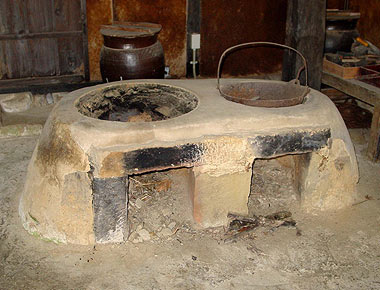
Japanese Kamado 竈
Click below link to learn much more about the Kamado.
Photo by Kyū Hondake (Nagasaki); courtesy JAANUS

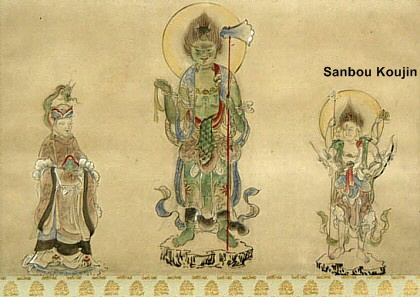
Scroll. No date or source given.
Photo courtesy this Japanese site.
(L) Gozu Tennō (M) Kasuga Daimyōjin (R) Sanbō Kōjin
(L) 牛頭天王 (M) 春日大明神 (R) 三宝荒神

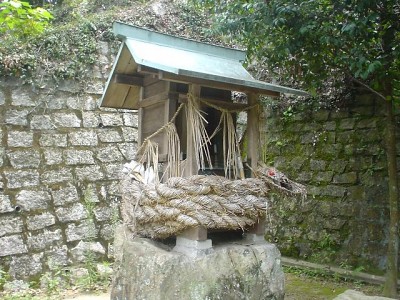
Small Shrine Dedicated to Sanbō Kōjin (Ibara, Japan)
Photo courtesy this Japanese site

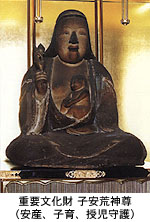
Koyasu Kōjin-sama
Wood, 1543 AD
Koyasu means “Child Giving”
Treasure of Sonbōji Temple 三宝寺, Murayama, Nagano
Designated an Important Cultural Asset
Photo courtesy www.sanbouji.com
Sanbōji Temle is a Jodo-sect temple
There are many Koyasu forms in Japan, but Kōjin-sama
is rarely shown in this fashion or with this iconography.
Nevertheless, the connection of Kōjin with the kitchen and home
is perhaps the main reason for this particular Kōjin manifestion.

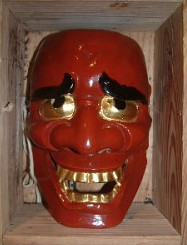
Kagura Mask of Kōjin
Photo courtesy this Japanese site.
http://www.komisen.net/Ogari32ban.html
高千穂写真ギャラリー「高千穂の夜神楽」(尾狩神楽)

Kagura Dances and Performances 神楽
Below text by Gabi Greve
http://darumasan.blogspot.com/2006/01/kagura-dance.html
Kagura dance and music are part of Shinto rituals for the gods. Kagura performances even today are related to ancient legends, and performed by priests and shrine maidens. Now, in some rural areas, it is considered a form of local art (minzoku geinoo) and preformed by the villagers themselves during the annual shrine festival. Some Kagura are more like festive folk-drama. The area of Chichibu is especially known for its local Kagura. Some performances last more than one day. Even children perform in local Kagura performances (kodomo kagura 子供神楽). Masks are mostly made from Japanese paper (washi) and many old costumes are treasures of the communities. There are various Kagura types throughout Japan. See Gabi Greve's Kagura page for many more details.
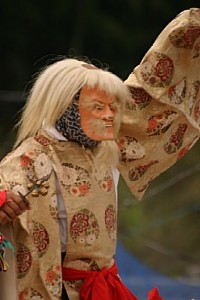 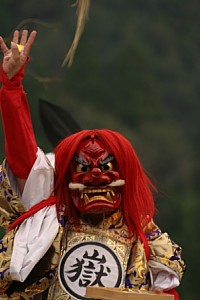
Kagura Scene at the Miya Festival
Photos courtesy of this Japanese site.
Above site says these are Kōjin performers,
but I am sceptical. The red-faced mask looks more like
the Shishi Lion or the Tengu.

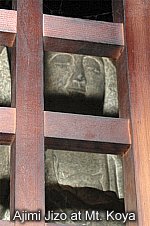  Kitchen Deities at Mt. Kōya 高野 Kitchen Deities at Mt. Kōya 高野
Mikuriya Myōjin 御厨明神
Ajimi Jizō 嘗試地蔵
Dokumi Jizō 毒味地蔵
Special Thanks to Gabi Greve for
teaching me about below deities.
When Shingon founder Kōbō Daishi 弘法大師 (or Kūkai 空海; d. 835) was still alive and living at Kōyasan 高野山, two of his disciples cared for his daily needs and brought his food. They were Aiman 愛慢 and Aigo 愛語. After their death, the two were deified and continued to serve Master Kōbō in the guise of Mikuriya Myōjin. Since they came from the land of Tosa 土佐 with Kūkai, they are also known as Tosa no Kuni Mikuriya Myōjin 土佐の国御厨明神. Their association with food and the hearth is further emphasized by their deified name Mikuriya 御厨. KURIYA 厨 is an old Japanese term for a dirt-floor kitchen, where food was prepared for the monks. Thus, their inclusion on this web page devoted to kitchen deities.
Even today, at Mt. Kōya, monks prepare special food and present it twice daily to Kōbō Daishi, whose body (it is said) still lies within the inner sanctuary known as Oku no In 奥の院. But today the job of testing the food (for poison) before presenting it to Master Kōbō is handled by Ajimi Jizō 嘗試地蔵 or 味見地蔵 (lit. Taste-Testing Jizō); also known as Dokumi Jizō 毒味地蔵 (lit. Poison Taste Jizō). Indeed, a small statue of Ajimi Jizō (standing inside a small enclosure) is located in front of Oku no In, and every morning at six and again around 10 am, the monks bring a tray of food for Master Kōbō, but first they give a bit of each item to Ajimi Jizō, who makes sure it isn't poisoned.
According to Mt. Kōya legends, Mikuriya Myōjin once inhabited the place where Ajimi Jizō now stands. Over time, Mikuriya Myōjin underwent transformation and re-manifested as Byōdō Ō 平等王. The latter is considered one of Jizō's many forms. Says Gabi Greve, who contributed this entry: "This is one example of the confusing theory of recruiting Shinto deities to the side of Buddhism."
Myōjin 明神, for example, is a term used to denote the Shinto origin of the deity, while Mt. Kōya and Kōbō Daishi represent the founding of Shingon 真言 Buddhism, a form of Esoteric Buddhism (Mikkyō 密教) brought to Japan from China by Kūkai. For more on the Mt. Kōya kitchen deities, please see Gabi Greve’s page. For more on Jizō, please see the Jizō page.

SIDE NOTES: Food Offerings to the Gods
The practice of scattering rice, sake, or money as offerings to the local deity or household deity is called Sanku. At the offering site, these are typically scattered around the four corners and into the center. Shinsen refers to food offerings. It includes Shinto staples like rice, rice cakes, sake, salt, and water. Just about anything will do, including fish, fowl, meat, seaweed, vegetables, fruits, or sweets. Some shrines still prepare the food in a consecrated kitchen building called the Shinsenden. Cooked food is referred to as Jukusen, raw food as Seisen, and vegetarian food as Sosen. See Shinto Concepts for a few more details.
SIDE NOTES
Rice and Mice by Gabi Greve. When farmers throw a handful of the first rice harvest of the year to the gods, the grains of rice stick to the nooks and crannies of wooden Buddhist statues in the vicinity. In winter, the mice come to pick out the grains, thus damaging the wooden statues. (Told by a priest in Northern Japan, where some statues of Enku where severely damaged by mice). Click here for full story.
SIDE NOTES
Sake Brewing at Shrines and Temples by John Gauntner.
Sake brewing in Japan was done mainly in shrines and temples in the middle ages. Interestingly, this was a period of huge strides in brewing methods and brewing technology. Click here for full story.

LEARN MORE
This page is dedicated to Kōjin, the syncretic Japanese deity of the hearth. Please visit the links given in above text & photo captions. There are other deities in Japan associated with the kitchen. Click any deity in below list to jump to that page.
- Daikokuten (Skt. Mahakala). The god of wealth, farmers, the kitchen, and provider of food. Daikokuten’s three-faced version shares some of the same attributes as Sanbou Koujin.
- Idaten (Skt. Skanda). Kitchen deity, especially at Zen monasteries. Idaten is also known as the protector of monks and monasteries.
- Monju Bosatsu (Skt. Manjushri). Deity of wisdom and intelligence, whose effigy was placed in residential kitchens during the Heian era to symbolize the wisdom and discipline needed to maintain the home.
- Suijin. Japanese Water Kami. Shinto goddess who protects not only fishermen, but serves as the patron saint of fertility, motherhood, and easy childbirth. She is the patron deity of the famous Tsukiji Fish Market in Tokyo, where she is enshrined, and is also reportedly enshrined in many domestic kitchens as an essential household god.
- Mikuriya Myōjin 御厨明神 and Ajimi Jizō 嘗試地蔵. Kitchen Deities in the Shingon Tradition at Mt. Kōya 高野. See above for details.
- MODERN CUISINE. Breakaway Japanese Kitchen, by Eric Gower
Recipes by Eric Gower. www.ericskitchen.com/
Says Eric-san: “My Japanese-related dishes are the result of a passion for good home-cooked food and experimentation that went on for about 15 years while I lived in Japan.”

|
 Do not confuse the kitchen deity Kōjin 荒神 with the monkey-related Kōshin 庚申 -- the latter is associated with Shōmen Kongō 青面金剛, a wrathful deity who expels the demons of sickness but looks very similar to Kōjin. Kōjin and Kōshin are separate deities. Do not confuse the kitchen deity Kōjin 荒神 with the monkey-related Kōshin 庚申 -- the latter is associated with Shōmen Kongō 青面金剛, a wrathful deity who expels the demons of sickness but looks very similar to Kōjin. Kōjin and Kōshin are separate deities.
|
|
Last Update = Sept. 12, 2010
|
|